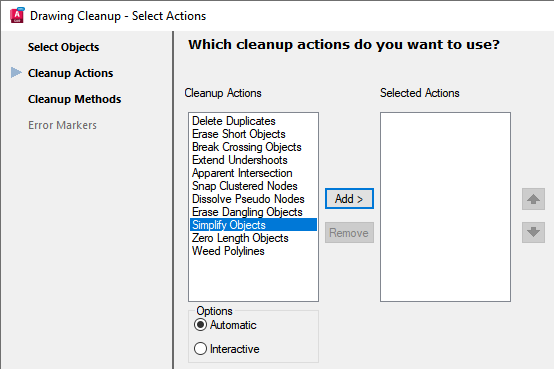As part of the project team’s work process, you can use a number of standard AutoCAD operations to eliminate redundant data from project drawings.
Check for Drawing Errors
The Audit command checks for errors in an open, active drawing. To run the command, click Application Menu  Drawing Utilities
Drawing Utilities  Audit
Audit
![]() .
.
Remove Unused Data
Two purge commands are available to remove unused data from your drawings.
- The main command removes nested, unused features. To run the command, click Application menu
 Drawing Utilities
Drawing Utilities  Purge
Purge
 .
.
- A secondary command removes unused registered applications (regapps) from a drawing. To run this command, enter -purge on the command line, then enter the command option “r” to remove regapps.
Locate Redundant Objects
The AutoCAD command QSELECT is useful for finding redundant objects in a drawing, as long as you have some idea of what to look for. For example, if you have been creating alignments and know that your drawing contains four actual alignments, you could use QSELECT to select all alignments. Then if the list includes more than four, you can delete the extra ones.
Repair Drawings
The Recover command locates and repairs damaged data in a drawing. The command is intended to be run when you open a drawing. Click Application menu  Drawing Utilities
Drawing Utilities  Recover
Recover
![]() , select the drawing, then click Open.
, select the drawing, then click Open.
Map 3D Cleanup
A powerful utility developed for AutoCAD Map 3D is also included with Autodesk Civil 3D. It enables you to delete duplicate objects, weed polylines, and do many other cleanup actions. You can set several parameters to control each action. Access the cleanup tools in one of two ways:
- At the bottom of the drawing window, click
 Workspace Switching and click
Planning and Analysis. On the ribbon, click
Tools tab
Workspace Switching and click
Planning and Analysis. On the ribbon, click
Tools tab  Map Edit panel
Map Edit panel  Drawing Clean Up
Drawing Clean Up
 .
.
- On the command line, enter MAPCLEAN.
The Drawing Cleanup dialog box opens, as shown in figure 17.

Figure 17: Map 3D drawing cleanup actions
While you can run several actions together, it is recommended that you do them one at a time for better monitoring and control.
Delete Corrupt Data
If you have a drawing that is corrupted and cannot be fixed by other means, you can use the Write Block (WBlock) command to write all drawing objects to a new drawing file. This can eliminate the corrupt data, and reduce the file size.
Several precautions apply when using WBlock with Autodesk Civil 3D data:
- Do not specify an insertion point, as doing that would change all the coordinate positions.
- If the drawing contains many Autodesk Civil 3D object or large objects, you may need to use alternative methods: export the data to LandXML, and then import it into a new drawing, or Export to AutoCAD, which explodes the Autodesk Civil 3D objects. If the objects are exploded and you want to re-create them, you may be able to use the exploded polylines or other simple entities as a starting point, or you may need to start from scratch.
- If you also want to copy sheet layouts from the drawing, use the AutoCAD DesignCenter tool to drag-and-drop them to the new drawing.
Remove Unneeded Objects
The Zoom Extents command enables you to see whether the drawing contains any unwanted objects outside the main design area. If so, you can delete them and reduce the drawing size.
